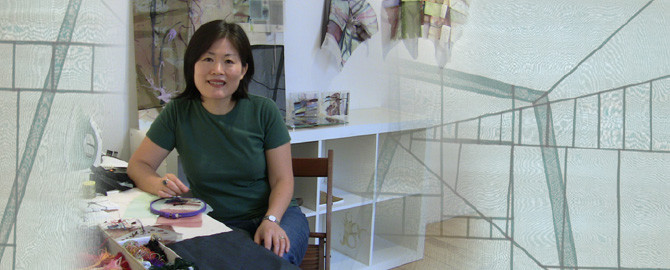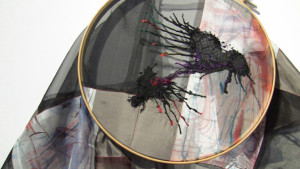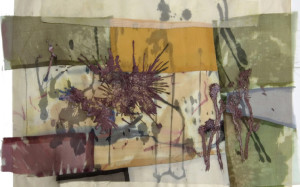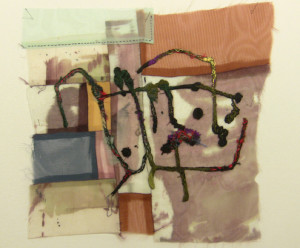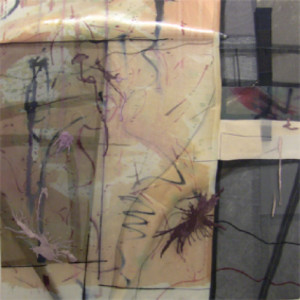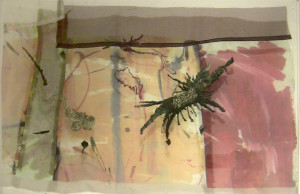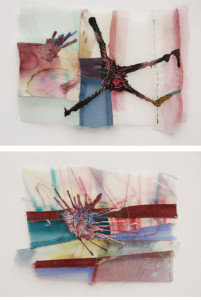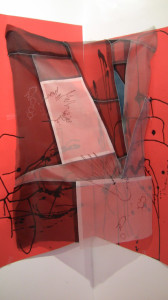Wonju Seo selects beautifully toned and textured materials that create images resembling sophisticated layered paintings or prints. Her sewing creates delicate lines carefully ‘drawn’ throughout the compositions.
Wonju Seo’s exhibited, “Through My Window,” at Coohaus Art, Chelsea, NYC in 2012. In August 2013 she was the residency artist at Coohaus Art.
In her own words…
Could you please introduce yourself and tell us a little about your background?
I am a contemporary Bojagi artist working primarily with various types of fabric such as silk, ramie and hemp, and mixed media. I was born and raised in Seoul Korea where I received my B.F.A in Fine Arts Painting from Hong-Ik University. After graduating from college, I worked as a package designer for about 2 years and commercial silk painting textile designer for more than 8 years. I came to the USA to continue my career and have been creating my work combining painting on sheer textile, collage, embroidery with a Korean traditional hand sewing technique called Bojagi, with a modern twist.
You started your art career by studying painting. How do you feel that this informs the work that you do with textiles? Why did you make the transition from paint to textiles?
Certainly, painting on canvas and working with textiles are two different ways to create art. Fortunately, I know both in terms of technique. Moreover, silk painting technique, which I learned from working as a textile designer, also helps me to understand and control materials better. I can even paint abstract or realism on pre-resisted silk using Gutta, just like I do on paper with water color paint. I enjoy watching purity and the intensity of colors on luxurious rich silk. I have to say my painting experience and knowledge always has been a foundation of my contemporary Bojagi work because color combination and dynamic composition are always major elements to start with.
The reason I started working with textile is that I was deeply inspired and fascinated by antique Bojagi’s (traditional wrapping cloth) in Korea by the beauty of their colors and shapes. These Bojagis’ were made by many unknown Korean women, who grew up in a traditional Confucian culture that limited their activities and freedom with domestic work in 19 C. They saved cut-offs from making Han-bok, which is tradition Korean clothing, and sewed into a square shape, in various sizes, for wrapping or transporting everyday items. Also, they made Bojagis’ for wrapping gifts on special occasions such as weddings and birthdays to show respect and for good luck. As a person, who studied in art, I was amazed by their creativity and purity. In my eyes, those Bojagis’ were not items for use anymore. They are contemporary abstract textile art that has great potential and the possibility to be continued generation to generation. Now, I am so proud that I became a part of it.
You are Korean, now you living in the US. Do you think that this effects your work? Does the Korean perspective differ from the American perspective in regards to the Art world? If so how?
When I was in Korea, I used to be a designer after graduating. I started creating my contemporary Bojagi work since I got married in America. I believe that living in America affected my work. I feel that my work is recognized by viewers in America as unique pieces that not only contain Korean culture as influence but also contemporary concerns with my passion and patience in art. People’s life style in America, especially in New York , is liberal in general and people enjoy something new, something different and something unique, depending on their taste and value. Moreover, the society and art organizations widely open their doors for all artists, who have strong creativity and responsibility of their work, no matter what cultural background they have. Of course, it takes time to prove that your work is qualified and at a certain level that meets their professional standard, but I believe that if your work has a strong concept and high quality of content, there are always chances to expose your work in major galleries and museums. This encourages me to continue creating new bodies of work over and over.
How has your style changed over the years?
For the first time, mostly, I used Korean traditional Bojagi hand sewing techniques and materials such as silk or ramie cut-offs from Korea. I brought them to my studio in America and displayed them on my working table widely as my color palette, and started sewing. I let my imagination and creativity guide me completely through the process. The artwork came out all different with the styles dependant on my feelings and energies of the day, therefore, I couldn’t estimate how long the piece would take to finish. I was into more of its process and enjoyed natural unexpected outcomes.
Since I felt that I had a good time creating my work in a traditional way, I started combining new techniques, such as silk painting, collage and embroidery on top of Bojagi in my own style. Also I started using mixed media such as pigment, foam board, cotton, and some found objects. Sometimes the size of my work was extended greatly and became an installation piece. I came up with the story as a theme and have been creating many different pieces in the same project. Certainly, my current work is more contemporary then my previous work.
What concepts are you currently exploring and what will you embark on next?
I have been working on a project called “Splash series” since last year. It is a new type of work that I started for my residency project at Coohaus Art, in Chelsea NYC. Splash series is about events that can happen anytime around us in our daily lives with or without our concern and desire. I transform these messy drop patterns to abstract motives that I can get unique stories out of it on my Bojagi work. I feel that those irregular abstract patterns remind me of some animals or human body shapes or feeling of actions in a very powerful way. Currently, I am using computer programs, such as Adobe Photoshop and Publisher to get various sizes and shapes of splash out of the original images. I am going to continue this project until I get the definition of “Splash” in my own visual language. I will try to find methods that I can develop my work in different forms, such as 3D or installation in a large scale.
Wonju Seo was born and raised in Seoul Korea, where she received her B.F.A in Fine Arts Painting from Hong-Ik University in 1988. After graduating college, she has worked as a silk painting artist. In 1998, she came to the United States to continue her career as an artist. She is the recipient of the 2012 Individual Artist Fellowship New Jersey State Council on the Arts and received Thomas Contemporary Quilt Recognition Award (Collector’s Choice) from Visions Art Museum, CA.
All images courtesy of Wonju Seo | www.wonjuseo.com
For more information on Hong Kong Art Tutoring please contact:
Gail Deayton
Telephone: +852 9722 8353
Email: info@hkarttutoring.com

